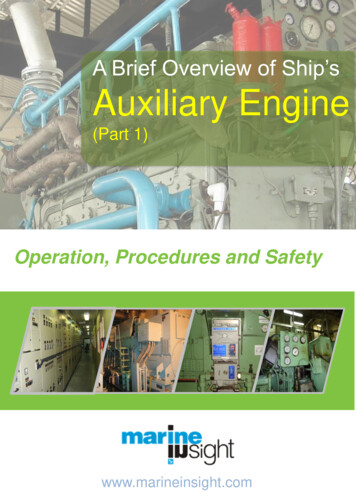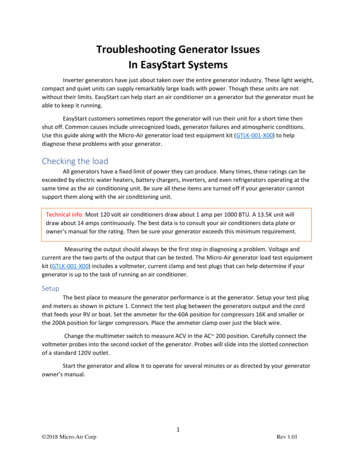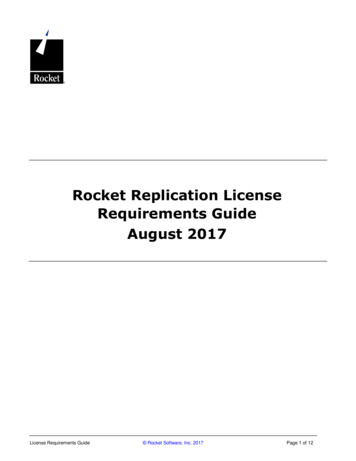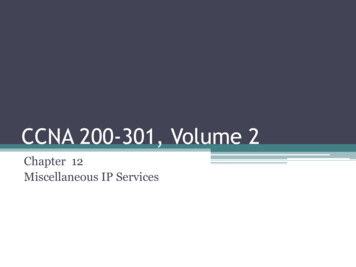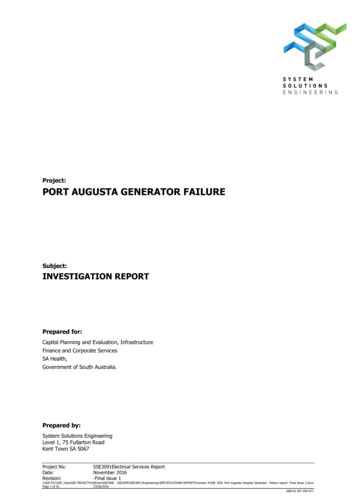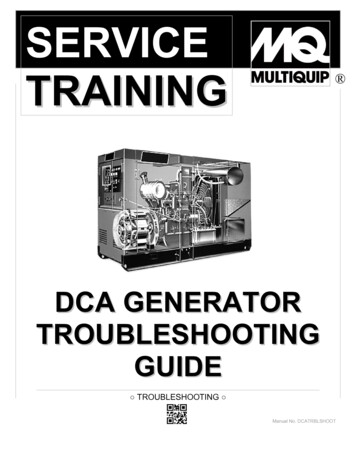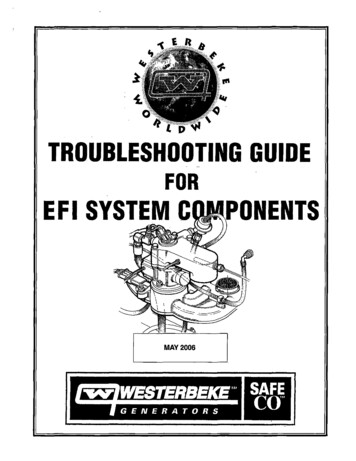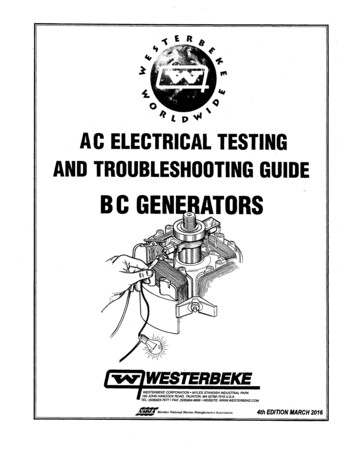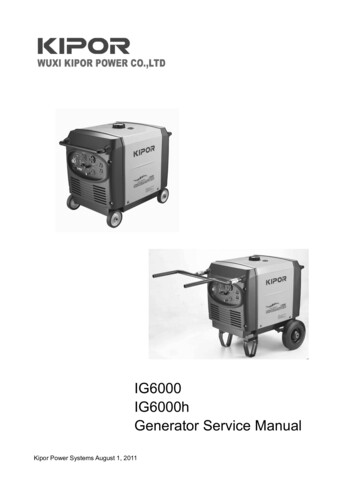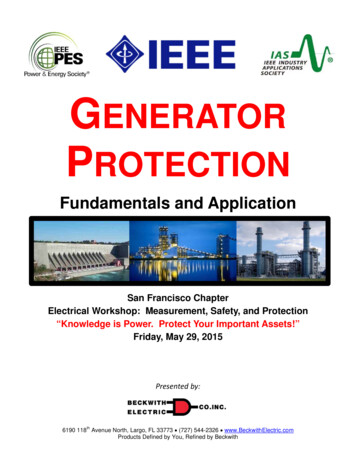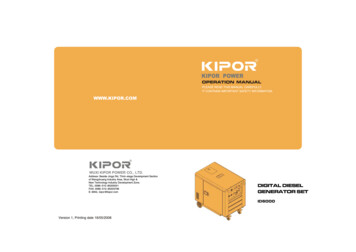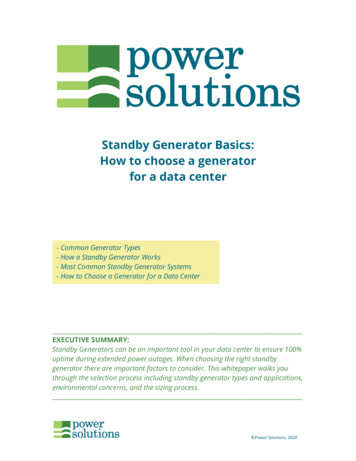
Transcription
Standby Generator Basics:How to choose a generatorfor a data center- Common Generator Types- How a Standby Generator Works- Most Common Standby Generator Systems- How to Choose a Generator for a Data CenterEXECUTIVE SUMMARY:Standby Generators can be an important tool in your data center to ensure 100%uptime during extended power outages. When choosing the right standbygenerator there are important factors to consider. This whitepaper walks youthrough the selection process including standby generator types and applications,environmental concerns, and the sizing process. Power Solutions, 2020
Standby generators are a critical element to any high availability powersystem. Data centers, network closets, hospitals, campuses andmanufacturing floors all have loads that require maximum uptime.Uninterruptable Power Supply (UPS) systems provide battery power for a fewminutes, but on-premise power generation is required for long-durationoutages. In most cases, that power source is a standby generator.Three Most Common Generator TypesThe first step in selecting a generator is to understand which type ofgenerator you need. The three most common types of generators areStandby, Prime, and Continuous.Standby power generators are most commonlyThe three most commonused in emergency power applications whentypes of generators areanother continuous power source, such as theStandby, Prime andutility, is the primary source of power. As theContinuous. Standbypower generators arename suggests, the generator is on standby,commonly in emergencyready to take over in the event that the utility orpower applications inother primary power source is no longersmall to medium sizeavailable. Standby generators aredata centers.recommended for use only during a poweroutage or for required maintenance andtesting. Standby generators are the most common generators for Tier I andTier II data centers.Prime generators are considered to have an unlimited run time and can beused in both standby applications or as the primary source of power. Primegenerators usually include an overload capacity of around 10% for shortdurations and are durable enough to provide maximum power to a variableload for an unlimited number of hours. Tier III and Tier IV data centersrequire prime generators.Continuous power generators are similar to prime, but generally supplypower to a constant load. Continuous generators are not rated for overloadconditions or variable loads. Because of these limitations, continuous powergenerators are rarely used in data center or critical applications where utilitypower is available. Power Solutions, 2020
The Standby Generator SystemThe generator system, often referred to as the genset, includes the standbygenerator, the automatic transfer switch (ATS), and the output powerdistribution. The ATS is fed by both the utility and the generator with theutility as the preferred source. When the ATS detects a problem with theutility power source, it automatically commands the generator to start andswitches the power feed to generator.Because the generator requires anywhere from a few seconds to severalminutes to supply consistent power to the load, an uninterruptable powersupply (UPS) protects the load with battery back up from the time utilitypower is lost until the generator can supply clean and consistent power.How a Standby Generator WorksWhen the UPS detects an interruption in power,A standbywithin milliseconds, it provides immediate batterygenerator isback-up to the load. So, as far as the protectedswitched on by theequipment is concerned, there is no powerATS after the UPSinterruption and existing processes and computationhas been turnedare not interrupted. Meanwhile, the ATS hason. The load isthen transferred todetected the utility outage, has commanded thethe generator.generator to start and has switched the power sourceto generator. Once the UPS recognizes the generatoras a stable source, it starts to transfer the load off battery and onto thegenerator. This is done in sequence and carefully managed by both theswitchgear and UPS firmware, so the load is not simply dumped onto thegenerator risking overload. When the utility power is restored, the ATS andswitchgear transfer the load back to utility and the generator is commandedto power down.Three Most Common Standby Generator ApplicationsIn most cases, the standby generator system will fall into one of threecategories – Emergency Standby Generator System, Multiple Isolated Power Solutions, 2020
Standby Generators, Multiple Generators Operating in Parallel with UtilitySystem.While theemergency standbyEmergency Standby Generator Systemgenset is theThe emergency standby generator system is thesimplest, somesimplest type of genset. There is a single utilityapplications requiresource, a single generator source, and one ATS. Inredundancy forthis case, the load is either supplied from the utilitypeak shaving orload shedding.or the generator. The generator and the utility arenever connected together. This type of generatorsystem improves reliability but does not provide any redundancy in the eventthe generator doesn’t start properly. This basic emergency standbygenerator system may or may not include a UPS and is most common insmaller, less critical applications.Multiple Isolated Standby GeneratorsIn critical applications when redundancy is required, the multiple isolatedstandby generator system is more common. In this configuration, multiplegenerators are connected to a paralleling bus feeding multiple transferswitches. This configuration is often used when N 1 or 2N redundancy isrequired. Multiple generator systems have a more complex controlmechanism as the units need to share the load under normal operatingconditions and be synchronized and paralleled together. This is typicallydone through programmable logic controllers (PLCs) in theswitchgear. Because of the high criticality of the IT load, multiple isolatedgenerator systems almost always include at least one UPS.Multiple Generators Operating in Parallel with Utility SystemWhile the emergency standby generator system and multiple isolatedstandby generator systems both require that power be supplied by either theutility or the generators through operation of one or more ATSs, whenmultiple generators are operating in parallel with the utility system, thegenerators are in parallel with the utility. This is most common inapplications where load shedding or peak shaving is required. The electricutility will likely have strict interconnection requirements for paralleling withthe utility and the system requires a complete and complex protection andcontrol scheme. Power Solutions, 2020
Standby Generator Basics: How to Choose a Generator for a Data CenterWhile you will need an electrical engineer to assist you in determining theexact specifications for your generator, ATS and/or switchgear, in most datacenter applications, you will find either standbyFactors to Consideror prime diesel generators in either single or- Proper Sizingmultiple isolated systems. In other words, not in- Generator Systemparallel with the utility. While gasoline, natural- Generator Typegas, liquid propane, steam and other fuels are- Application Environmentavailable, diesel generators remain the topchoice because of the quick start-up and power of the internal combustionengine. Additionally, diesel remains one of the most readily available andeconomic fuel types.Factors to consider when choosing a generatorHow to size a generatorIn most commercial applications, the general rule of thumb is to size thegenerator at 2x the UPS load while factoring in the PUE. The rationale is thatthe generator capacity beyond what is required for the load connected to theUPS will provide enough power for the mechanicals, cooling, and othercritical building systems.More specifically, start by calculating the target power usage effectiveness(PUE) of the data center. This is the ratio of power delivered to the facility topower delivered to the IT load. A PUE of 1.2 is considered very efficient. Let’ssay the site has a 500kVA UPS with a PUE of 1.2. If you take the UPS load andmultiple times 2, you get 1000kVA. Multiply that by the PUE of 1.2, you have1200kVA. From there, you would round up to the next nominal generatorcapacity which may vary by manufacturer, but in this case, would likely be1250kVA.Generator SystemWhen deciding whether to use a generator system with a single generator, orone with multiple generators, the biggest question to ask is whether or notyou need redundancy. While generally this is a question left to the datacenter operator and senior management, some facilities such as hospitals or Power Solutions, 2020
college campuses have regulatory rules in place than mandate a certain levelof redundancy.If a single generator system is adequate, it is worth considering sizing thebattery capacity of the UPS for some additional run time to allow extra timeto initiate graceful shut-down of non-critical loads in the event the generatordoesn’t come online as quickly as expected.Generator TypeIf the design calls for a single emergency generator, then a standbygenerator is likely the most appropriate for your application. For highlycritical loads and redundant configurations, a prime generator may bepreferred or even required depending again upon industry regulations andthe Uptime Institute data center tier you are striving for. Tier III and Tier IVdata centers require prime generators and a minimum of N 1 redundancy.Fuel source is also an important consideration. As mentioned earlier, manyfuel types are available, but diesel remains the gold standard for data centerapplications because of its short start-up time, power, and reliability. Forhighly critical applications, duel redundant fuel sources may be considered.EnvironmentalAside from choosing the generator and generator system itself, other factorsto consider when designing a power system are: Exhaust and local EPA regulationsNoise and local noise ordinancesAesthetics and any zoning regulations that may require hiding thegenerator from plain siteFoundation or padding size and typeGenset derating due to high altitudes or excessive ambient temperaturesFuel storage tanks and hazardous waste considerationsEnvironmental hazards that can block or contaminate the intake and/orexhaust such as heavy snow or salty air near the coast Power Solutions, 2020
ConclusionThere are many different things to consider when selecting a generator. Eachconfiguration is unique and requires careful planning and consideration. It’sworth emphasizing that this article is intended as a general guideline only. Anelectrical engineer familiar with the building power distribution system is themost qualified professional to properly size the generator for yourrequirement. At a minimum, the engineer will require an electrical one-lineof the power system to begin sizing and configuration of the generator andATS or switchgear.Power Solutions LLC can assist with the process. Our team has successfullyengineered, furnished and installed generators and power systems forcustomers all over the country. Power Solutions LLC is a national vendoragnostic solutions provider of power products and services for IT,manufacturing facilities, and telecommunications applications. As a valueadded reseller for more than 20 different manufacturers, we help youconfigure the best solution for your specific application. With access to sucha wide range of power products and services for both AC and DCapplications, we offer customized turn-key solutions that simplify projectexecution and procurement with a single point of contact.For more details about how to choose the right Standby Generator foryour application, contact Power Solutions. 800-876-9373 orsales@power-solutions.comPower Solutions PO Box 100 Barrington RI 02806 Power Solutions, 2020
Standby Generator Basics: How to Choose a Generator for a Data Center While you will need an electrical engineer to assist you in determining the exact specifications for your generator, ATS and/or switchgear, in most data center applications, you will find either standby or prime diesel
